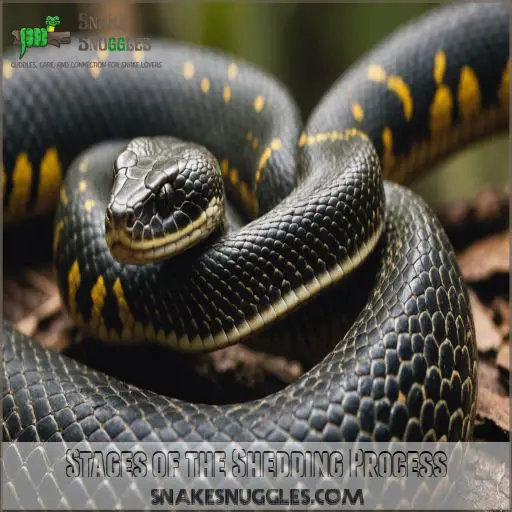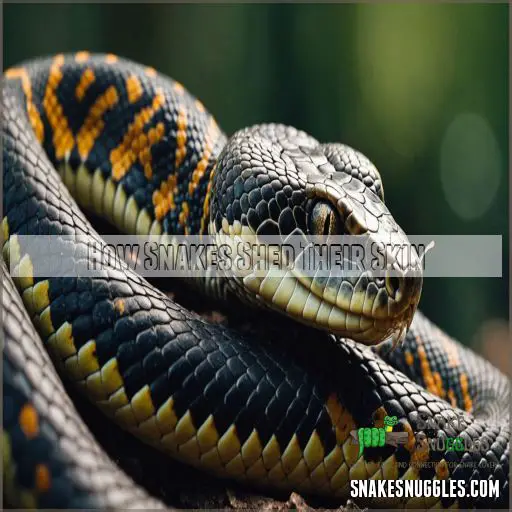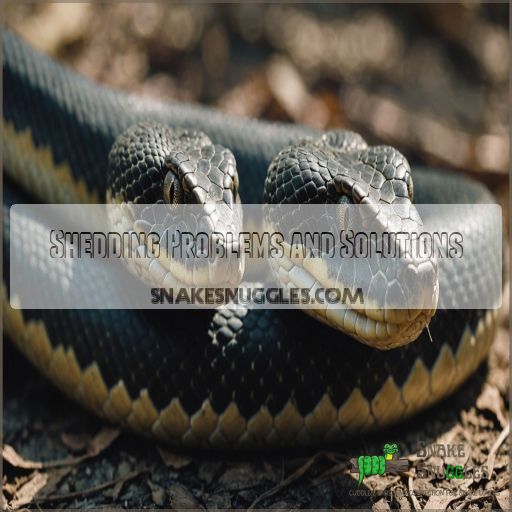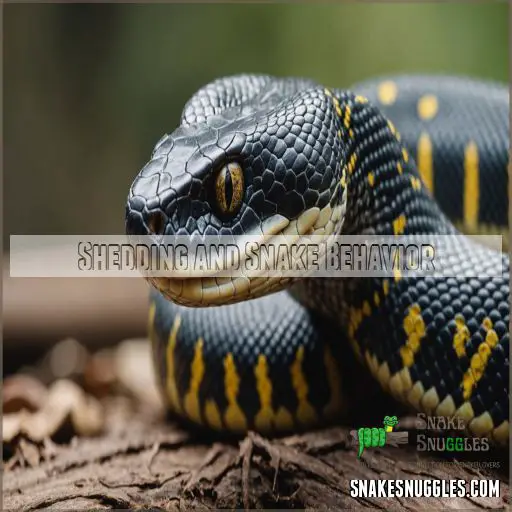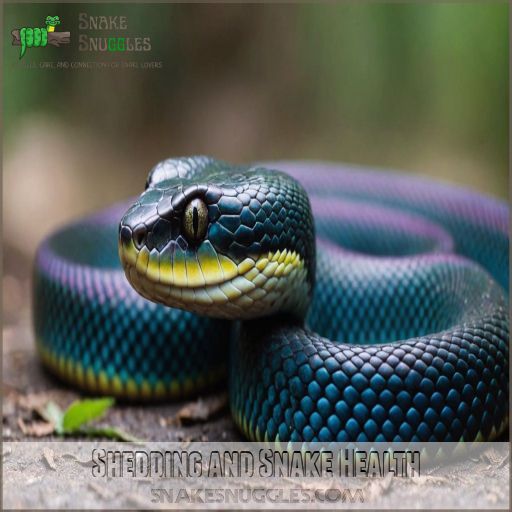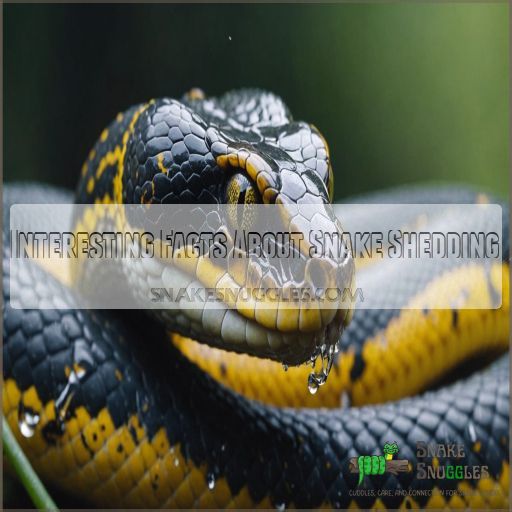This site is supported by our readers. We may earn a commission, at no cost to you, if you purchase through links.
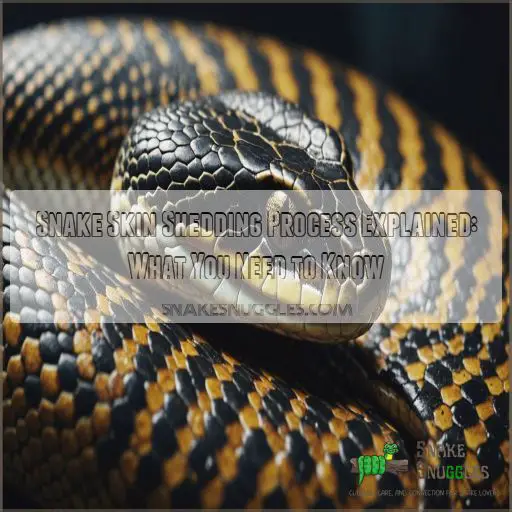 When your snake’s ready to shed its old skin, you’ll notice its eyes getting cloudy and its colors fading.
When your snake’s ready to shed its old skin, you’ll notice its eyes getting cloudy and its colors fading.
That’s the snake’s way of telling you it’s time for a fresh start!
The shedding process begins with your snake rubbing its nose against rough surfaces to loosen the old layer.
Then, it’ll slowly wriggle out of the skin, revealing a brand new, vibrant coat underneath.
Shedding is essential for your snake’s growth and health, so don’t be alarmed if it happens a few times a year.
Just make sure the environment is just right, and your scaly friend will shed like a champ!
Stay tuned for more tips on ensuring a smooth shedding process for your ball python.
Table Of Contents
- Key Takeaways
- What is Snake Skin Shedding?
- Stages of the Shedding Process
- How Snakes Shed Their Skin
- Shedding Problems and Solutions
- Shedding and Snake Behavior
- Shedding and Snake Health
- Interesting Facts About Snake Shedding
- Frequently Asked Questions (FAQs)
- Is it painful when snakes shed their skin?
- How do snakes start the process of shedding?
- How many hours does it take a snake to shed its skin?
- Do snakes come back to where they shed their skin?
- How does shedding frequency vary with seasons?
- Can diet impact a snakes shedding cycle?
- Are there specific environmental conditions that facilitate shedding?
- Does shedding affect a snakes social interactions?
- How can you safely observe a snake during shedding?
- Conclusion
Key Takeaways
- Shedding is an essential process for your snake’s growth, health, and survival; it helps them remove parasites and regenerate their skin. Expect your snake to shed 2-4 times per year, with younger snakes shedding more frequently.
- During the shedding process, you’ll notice your snake’s eyes becoming cloudy and its colors fading. This is your snake’s way of telling you it’s time for a fresh start. They’ll rub their nose on rough surfaces to loosen the old skin, then slowly wriggle out to reveal a vibrant new coat.
- Don’t handle your snake while it’s shedding, as they may become defensive and strike due to their impaired vision. Instead, give them space and let them focus on their shedding process in peace. Provide a humid hide and monitor the environment to ensure a smooth shedding process.
- If you notice any shedding problems, such as stuck shed or skin infections, it could be a sign of deeper health issues. Keep a close eye on your snake’s shedding habits and consult a vet if you have any concerns; they’re the real heroes when it comes to your scaly friend’s well-being.
What is Snake Skin Shedding?
Ever wondered why your pet snake occasionally leaves behind a ghostly reminder of itself?
Snake skin shedding, or ecdysis, is a fascinating process where snakes slip out of their old, too-tight skin like it’s last season’s sweater, allowing them to grow and remove unwanted hitchhikers like parasites.
Definition of Ecdysis
Ecdysis, or the snake shedding process, is essential for skin regeneration.
It’s like a reptile’s costume change!
This important evolution in reptile shedding allows their skin to protect and grow effectively.
Importance of Shedding for Snakes
Shedding isn’t just a snake beauty treatment; it’s a key process for growth, health, and survival.
Removing that old skin helps fend off pesky parasites.
So, next time your slithering friend sheds, celebrate their fresh start!
Frequency of Shedding in Snakes
Snakes typically shed their skin two to four times a year, with younger snakes shedding more frequently as they continue growing, like hatchlings.
The shedding process can vary based on the snake’s age, diet, and environmental conditions, like optimal humidity levels.
Factors Affecting Shedding in Snakes
You know, shedding’s like a snake’s fashion week, influenced by humidity levels, enclosure size, and age.
Stress and diet matter too.
Young snakes shed often, showcasing vibrant banding patterns.
Keep an eye on parasites affecting those cool snake markings!
Stages of the Shedding Process
If you’re ever wondering why your snake looks like it’s having a bad day, it might just be shedding its skin.
Understanding these stages can make you a more attentive snake parent and might stop you from panicking when your slithery friend starts rubbing its nose on everything!
Day 1-2: Skin Preparation
At the shedding kick-off, your snake’s skin subtly signals change, turning dull while its belly may show a pink tint.
It’s like nature’s way of saying, "Get ready!"
These early signs are clear indicators.
Days 3-7: Eye Opaqueness and Skin Fading
As your snake’s eyes become cloudy and its skin fades, don’t fret – this is a natural part of the shedding cycle.
Keep an eye out for:
- Increased skin dullness
- Bluish hue to the eyes
- Potential health concerns if shedding is delayed
Day 10-12: Snake Rubs Nose to Loosen Skin
As the snake’s eyes clear, it’s go-time for some shedding behavior!
It rubs its nose, practicing its unique nose-rubbing technique.
This dance with friction and shedding helps loosen skin, preparing for its upcoming makeover moment.
Day 12-14: Snake Sheds Skin
Finally, it’s showtime! Your snake gracefully wriggles its way out of the old skin, like slipping out of yesterday’s clothes.
This shedding process, though seemingly effortless, is a key turning point for a snake’s health.
How Snakes Shed Their Skin
Watch as nature turns on its makeover magic when snakes shed their skin, starting with hormones loosening the outer layer.
It’s like slipping out of last season’s fashion, leaving behind a perfectly crafted replica in the wild.
Hormonal Changes Triggering Shedding
Snakes shed their skin due to hormonal changes that loosen the bond between the inner and outer layers.
This cyclical process is triggered by the snake’s endocrine system, responding to factors like growth, stress, and seasonal changes.
Snakes Rub Head on Abrasive Surfaces
You’ve noticed that hormonal changes signal a head-rubbing dance on rough surfaces. This isn’t random; it’s how they loosen skin.
Keep an eye on:
- Rough textures in the enclosure
- Snake’s head motion
- Surface preference
- Skin friction marks
- Abrasive materials nearby
Snakes Crawl Through Tight Spaces to Shed Skin
Imagine you’re trying on a pair of jeans that are too tight; that’s how snakes feel during shedding.
They use tight spaces to wriggle free of old skin, an essential snake shedding habit that facilitates their growth.
Shed Skin is Left Behind
The leftover shed skin is like a snake’s calling card, revealing unique patterns and size.
It’s often collected by enthusiasts or simply disposed of.
Consider it nature’s way of recycling—the snake’s own personal spring cleaning ritual.
Shedding Problems and Solutions
Shedding is a natural process for snakes, but it can sometimes go awry.
If you notice any issues with your snake’s skin shedding, don’t worry – there are plenty of solutions to help them through this important stage.
Causes of Shedding Problems
Ah, shedding problems! Proper humidity and temperature are really important. Check these factors:
- Humidity
- Temperature
- Nutrition
- Parasites
Signs of Shedding Problems
You notice stuck shed, dry skin, or uneven shed—these can lead to a skin infection.
Importance of Humidity and Temperature
Humidity and temperature greatly affect shedding. Keep humidity levels ideal for snakes to support their health.
Providing a Humid Hide and Water Bowl
Provide a humid hide and water bowl to help your snake shed successfully.
Monitoring Snake Behavior and Appearance
When shedding, watch for eye opaqueness and skin changes, or unusual behavior like hiding habits and appetite changes.
Age and Growth Rate
Growing like weeds, young snakes shed more often. Adults? They follow a slower, steady shedding pattern.
Nutrition and Health
A snake’s diet affects shedding. Make sure: 1. Balanced diet, 2. Necessary supplements, 3. Proper hydration, 4. Healthy growth without illness.
Environmental Factors
Proper environmental conditions are key for successful snake shedding, and that includes boosting humidity for shedding.
Maintain ideal humidity and temperature in the enclosure.
| Humidity | Temperature |
|---|---|
| 50-70% | Warm side: 85-90°F [br]Cool side: 75-80°F |
Providing a humid hide and clean water can facilitate shedding.
Presence of Parasites or Bacteria
As we navigate health implications, consider shedding’s role in parasite prevention and bacterial control. Hygiene impacts shedding frequency.
Shedding and Snake Behavior
When your snake goes through shedding, don’t be surprised if it suddenly becomes a bit more reclusive and defensive.
It’s a challenging time for them, and handling is a big no-no, as they may be hiding in their favorite spot, wondering why their vision seems to have gone on vacation!
Changes in Snake Behavior During Shedding
Handling concerns increase during shedding, as some snakes become defensive, even striking unexpectedly!
Like a teenager with a bad haircut, they feel awkward, shy, or even cranky.
Understand this behavior helps us navigate shedding interactions with your snake.
Snakes Become Shy and Hide During Shedding
During the shedding process, snakes often become shy and retreat to their hiding spots. This behavior helps them feel secure and protected as their vision becomes impaired. Avoid handling them to prevent added stress.
During the shedding process, snakes often become shy and retreat to their hiding spots.
This behavior helps them feel secure and protected as their vision becomes impaired.
Avoid handling them to prevent added stress.
- Snakes hide to feel safe and secure.
- Impaired vision makes them more cautious.
- Handling can increase stress during this vulnerable time.
Snakes May Strike Defensively During Shedding
Shedding stress, often triggered by inadequate enclosure conditions such as poor substrate ventilation, makes snake behavior unpredictable, often leading to defensive strikes due to temporary vision loss.
Imagine being unable to see clearly—naturally, you’ve got handling concerns!
Allow them space; patience will keep you both out of harm’s way.
Importance of Not Handling Snakes During Shedding
When snakes are shedding, give them space to avoid stress or injury from defensive reactions due to impaired vision.
Here’s why it matters:
- Protects their health
- Keeps you safe
- Reduces stress
- Encourages natural behavior
Shedding and Snake Health
When your snake sheds its skin, it’s like a health checkup, showing they’re growing and free from pests.
Keep a close eye on their shedding habits—if things go awry, a snake vet might be the hero your scaly friend needs!
Shedding as a Sign of Health
How often does your snake shed its skin?
Healthy snakes typically shed two to four times a year.
This is a natural process that reveals their vibrant colors and signifies they’re thriving in their environment.
Shedding Problems as a Sign of Illness
Sure, a healthy shed shines like a new coat of paint, but problems can signal deeper issues. Look out for these: 1. Skin infections due to incomplete sheds.
- Nutritional deficiencies.
- Stress factors or environmental issues.
Importance of Monitoring Shedding
Spotting shedding problems can feel like finding a needle in a haystack.
Monitor shedding frequency, skin quality, and behavior changes to assess health.
Use this handy table for tracking:
| Aspect | Check |
|---|---|
| Shedding Frequency | Regular? |
| Skin Quality | Clear, even? |
| Behavior Changes | More reclusive? |
| Health Signs | Normal appetite? |
| Vet Visits | Needed soon? |
Consulting a Veterinarian for Shedding Issues
Spotting shedding problems is like finding a needle in a haystack.
If your snake’s shedding veers into dodgy territory, a vet visit is your knight in shining armor, diagnosing skin infections and offering treatment options to restore your snake’s health.
Interesting Facts About Snake Shedding
Did you know snakes shed their skin in one complete piece, unlike most animals?
The shed skin can actually reveal fascinating details about the snake, like its scale patterns and eye placement.
Shedding is also an important process that helps snakes remove harmful parasites.
Snakes Shed Skin in One Piece
Regarding snake shedding, they shed skin in one seamless piece, unlike lizards, who prefer the jigsaw puzzle approach.
This unique shedding process allows snakes to grow and stay healthy, a natural process for snakes.
Just like slipping out of an uncomfortable sweater, snakes embrace their new selves!
Shed Skin Reveals Details About the Snake
Finding snake skin on the ground can be like discovering a secret diary!
This shed skin isn’t just old news—it’s full of fascinating details.
Here are three things it can tell you:
- Snake Scales
- Pattern Analysis
- Age Estimation
Snakes Shed Skin to Remove Parasites
Just as a detective finds clues in mysterious places, analyzing shed skin reveals fascinating details about the snake.
Shedding is also a key way to kick parasites to the curb. These uninvited guests meet their match when old skin is replaced.
| Parasite Types | Shedding Frequency | Parasite Prevention |
|---|---|---|
| Mites | Monthly | Clean habitat |
| Ticks | Bi-monthly | Quarantine new items |
| Lice | Seasonally | Regular checks |
Frequently Asked Questions (FAQs)
Is it painful when snakes shed their skin?
Snakes don’t feel pain when shedding, although it might get a bit itchy, like wearing an itchy sweater.
However, a tough shed can crank up the discomfort.
Keeping the enclosure humid can help them shed smoothly (Source).
How do snakes start the process of shedding?
Imagine this: your snake starts by releasing a special hormone, loosening the outer skin.
They might feel like a kid trying to escape a tight sweater, rubbing their head on surfaces to begin the shed.
How many hours does it take a snake to shed its skin?
The shedding process can take anywhere from a few hours to a couple of days, depending on the snake’s size and age.
Younger, growing snakes tend to shed more quickly than their older counterparts.
Do snakes come back to where they shed their skin?
Imagine stumbling upon an old sweater you lost; snakes don’t revisit their old skins.
Once shed, they move on and explore fresh adventures.
Each skin left behind is like a telltale breadcrumb of their journey.
How does shedding frequency vary with seasons?
In colder seasons, snakes take a breather from shedding due to slowed growth, but come spring and summer, they’re back at it like clockwork, rejuvenating their coats to accommodate growth and remove pesky parasites (Source).
Shedding is a regular process for snakes, occurring more frequently in warmer months.
Can diet impact a snakes shedding cycle?
A snake’s diet is key, as a finesse-tuned orchestra, in its shedding cycle. You could say a well-nourished snake sheds magnificently regularly.
Balanced nutrition leads to smooth ecdysis; poor diet might skip a beat, causing shedding issues.
Are there specific environmental conditions that facilitate shedding?
To facilitate a smooth shedding process, you’ll want to maintain ideal temperature (75-85°F) and humidity (50-70%) levels in your snake’s enclosure.
Providing a humid hide can also help soften the old skin for an easy shed.
Does shedding affect a snakes social interactions?
During shedding, a snake might act like a moody teenager, avoiding its pals due to cloudy vision and vulnerability.
They prefer solitude, hiding away to focus on their wardrobe change without interruption.
It’s a natural snake strategy!
How can you safely observe a snake during shedding?
You can safely observe a snake shedding by giving it space and not handling it.
Use a humid hide for moisture, and keep an eye on humidity levels.
Watch from a distance and enjoy nature’s makeover show!
Conclusion
Imagine peeling off an old, shabby coat to reveal a shiny new one underneath—that’s exactly what your snake does during the incredible skin shedding process, which is a natural part of a snake’s life cycle. Learn more about shedding frequency. This natural ritual is key for your scaly buddy’s health and growth.
Understanding the "snake skin shedding process explained" helps you ensure optimal shedding conditions (optimal shedding conditions) are met, keeping your pet comfy and happy
.


